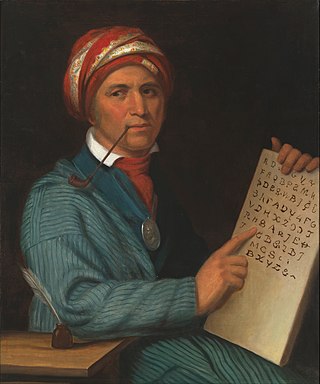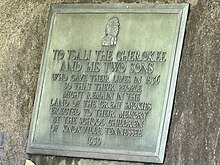
The Cherokee people are one of the Indigenous peoples of the Southeastern Woodlands of the United States. Prior to the 18th century, they were concentrated in their homelands, in towns along river valleys of what is now southwestern North Carolina, southeastern Tennessee, southwestern Virginia, edges of western South Carolina, northern Georgia and northeastern Alabama consisting of around 40,000 square miles.

The Muscogee, also known as the Mvskoke, Muscogee Creek or just Creek, and the Muscogee Creek Confederacy, are a group of related Indigenous peoples of the Southeastern Woodlands in the United States. Their historical homelands are in what now comprises southern Tennessee, much of Alabama, western Georgia and parts of northern Florida.

The Battle of Tippecanoe was fought on November 7, 1811, in Battle Ground, Indiana, between American forces led by then Governor William Henry Harrison of the Indiana Territory and tribal forces associated with Shawnee leader Tecumseh and his brother Tenskwatawa, leaders of a confederacy of various tribes who opposed European-American settlement of the American frontier. As tensions and violence increased, Governor Harrison marched with an army of about 1,000 men to attack the confederacy's headquarters at Prophetstown, near the confluence of the Tippecanoe River and the Wabash River.

Tecumseh was a Shawnee chief and warrior who promoted resistance to the expansion of the United States onto Native American lands. A persuasive orator, Tecumseh traveled widely, forming a Native American confederacy and promoting intertribal unity. Even though his efforts to unite Native Americans ended with his death in the War of 1812, he became an iconic folk hero in American, Indigenous, and Canadian popular history.

Elias Boudinot was a writer, newspaper editor, and leader of the Cherokee Nation. He was a member of a prominent family, and was born and grew up in Cherokee territory, now part of present-day Georgia. Born to parents of mixed Cherokee and European ancestry and educated at the Foreign Mission School in Connecticut, he became one of several leaders who believed that acculturation was critical to Cherokee survival. He was influential in the period of removal to Indian Territory.

Tecumseh's War or Tecumseh's Rebellion was a conflict between the United States and Tecumseh's confederacy, led by the Shawnee leader Tecumseh in the Indiana Territory. Although the war is often considered to have climaxed with William Henry Harrison's victory at the Battle of Tippecanoe in 1811, Tecumseh's War essentially continued into the War of 1812 and is frequently considered a part of that larger struggle. The war lasted for two more years, until 1813, when Tecumseh and his second-in-command, Roundhead, died fighting Harrison's Army of the Northwest at the Battle of Moraviantown in Upper Canada, near present-day Chatham, Ontario, and his confederacy disintegrated. Tecumseh's War is viewed by some academic historians as the final conflict of a longer-term military struggle for control of the Great Lakes region of North America, encompassing a number of wars over several generations, referred to as the Sixty Years' War.

The Shawnee are a Native American people of the Northeastern Woodlands. Their language, Shawnee, is an Algonquian language.

Tenskwatawa was a Native American religious and political leader of the Shawnee tribe, known as the Prophet or the Shawnee Prophet. He was a younger brother of Tecumseh, a leader of the Shawnee. In his early years Tenskwatawa was given the name Lalawethika, but he changed it around 1805 and transformed himself from a hapless, alcoholic youth into an influential spiritual leader. Tenskwatawa denounced the Americans, calling them the offspring of the Evil Spirit, and led a purification movement that promoted unity among the Indigenous peoples of North America, rejected acculturation to the American way of life, and encouraged his followers to pursue traditional ways.

The Ridge, later known as Major Ridge was a Cherokee leader, a member of the tribal council, and a lawmaker. As a warrior, he fought in the Cherokee–American wars against American frontiersmen. Later, Major Ridge led the Cherokee in alliances with General Andrew Jackson and the United States in the Creek and Seminole wars of the early 19th century.

The Treaty of New Echota was a treaty signed on December 29, 1835, in New Echota, Georgia, by officials of the United States government and representatives of a minority Cherokee political faction, the Treaty Party.

William Holland Thomas was an American merchant, lawyer, politician and soldier.
Cheeseekau was a war chief of the Kispoko division of the Shawnee Nation. Also known as Pepquannakek (Gunshot), Popoquan (Gun), Sting, and Chiksika. Although primarily remembered as the eldest brother and mentor of Tecumseh, who became famous after Cheeseekau's death, Cheeseekau was a well-known leader in his own time, and a contemporary of Blue Jacket.
Turtle-at-Home, or Selukuki Wohelengh, was a Cherokee warrior and leader, brother and chief lieutenant of Dragging Canoe, a war-chief in the Cherokee–American wars.

Tecumseh's confederacy was a confederation of Native Americans in the Great Lakes region of North America which formed during the early 19th century around the teaching of Shawnee leader Tenskwatawa. The confederation grew over several years and came to include several thousand Native American warriors. Shawnee leader Tecumseh, the brother of Tenskwatawa, became the leader of the confederation as early as 1808. Together, they worked to unite the various tribes against colonizers from the United States who had been crossing the Appalachian Mountains and occupying their traditional homelands.
The Cherokee people of the southeastern United States, and later Oklahoma and surrounding areas, have a long military history. Since European contact, Cherokee military activity has been documented in European records. Cherokee tribes and bands had a number of conflicts during the 18th century with Europeans, primarily British colonists from the Southern Colonies. The Eastern Band and Cherokees from the Indian Territory fought in the American Civil War, with bands allying with the Union or the Confederacy. Because many Cherokees allied with the Confederacy, the United States government required a new treaty with the nation after the war. Cherokees have also served in the United States military during the 20th and 21st centuries.

Cherokee history is the written and oral lore, traditions, and historical record maintained by the living Cherokee people and their ancestors. In the 21st century, leaders of the Cherokee people define themselves as those persons enrolled in one of the three federally recognized Cherokee tribes: The Eastern Band of Cherokee Indians, The Cherokee Nation, and The United Keetoowah Band of Cherokee Indians.

The Cherokee Nation was a legal, autonomous, tribal government in North America recognized from 1794 to 1907. It was often referred to simply as "The Nation" by its inhabitants. The government was effectively disbanded in 1907, after its land rights had been extinguished, prior to the admission of Oklahoma as a state. During the late 20th century, the Cherokee people reorganized, instituting a government with sovereign jurisdiction known as the Cherokee Nation. On July 9, 2020, the United States Supreme Court ruled that the Muscogee (Creek) Nation had never been disestablished in the years before allotment and Oklahoma Statehood.
The Chickamauga Cherokee were a Native American group that separated from the greater body of the Cherokee during the American Revolutionary War and up to the early 1800s.

Quatawapea or John Lewis, also known as Captain Lewis and Colonel Lewis and ‘’’Captain Johnny’’’, was a Shawnee leader for whom Lewistown, Ohio, is named.















